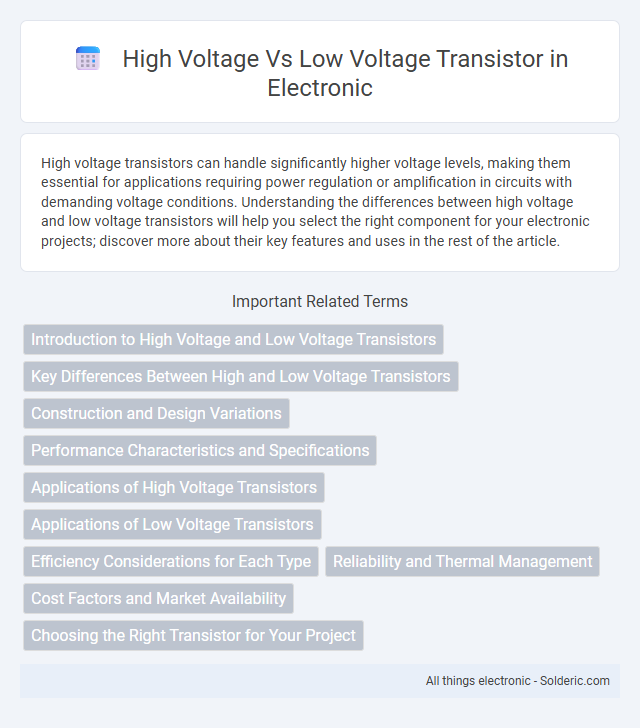High voltage transistors can handle significantly higher voltage levels, making them essential for applications requiring power regulation or amplification in circuits with demanding voltage conditions. Understanding the differences between high voltage and low voltage transistors will help you select the right component for your electronic projects; discover more about their key features and uses in the rest of the article.
Comparison Table
| Feature | High Voltage Transistor | Low Voltage Transistor |
|---|---|---|
| Voltage Rating | > 100V, typically up to several kV | < 100V, commonly 3V to 50V |
| Applications | Power supplies, motor drives, RF amplifiers, industrial equipment | Integrated circuits, low-power devices, digital logic circuits |
| Switching Speed | Generally slower due to larger junctions and packaging | Higher speed suitable for high-frequency applications |
| Power Handling | High power dissipation and current capability | Lower power and current capacity |
| Size and Cost | Larger die size, more expensive | Smaller die, cost-effective for mass production |
| Breakdown Voltage | High breakdown voltage to withstand large voltages | Lower breakdown voltage limits |
Introduction to High Voltage and Low Voltage Transistors
High voltage transistors are designed to operate at voltages exceeding 100 volts, enabling them to handle power-intensive applications in power supplies, automotive systems, and industrial equipment. Low voltage transistors function efficiently at voltages below 30 volts, optimized for logic circuits, signal processing, and portable electronic devices. Key differences include their semiconductor structure, breakdown voltage, and thermal stability, which dictate their suitability for specific voltage ranges and performance requirements.
Key Differences Between High and Low Voltage Transistors
High voltage transistors operate efficiently at voltages typically above 100V and are designed with enhanced insulation and thicker gate oxides to withstand higher electric fields, while low voltage transistors function optimally below 100V with faster switching speeds and lower power losses. The key differences include breakdown voltage, power handling capability, and application suitability, where high voltage transistors are used in power supplies and motor drives, and low voltage types are favored in digital circuits and signal processing. Understanding these distinctions helps you select the appropriate transistor to ensure reliability and performance in your electronic design.
Construction and Design Variations
High voltage transistors feature thicker gate oxides and wider spacing between junctions to withstand higher electric fields and prevent breakdown, whereas low voltage transistors utilize thinner gate oxides and compact geometries for enhanced switching speed and efficiency. The construction of high voltage transistors often includes additional drift regions and optimized doping profiles to manage high voltage stress and reduce leakage currents. Design variations also involve the use of specialized semiconductor materials like silicon carbide (SiC) for high voltage devices, compared to conventional silicon in low voltage transistors.
Performance Characteristics and Specifications
High voltage transistors are designed to handle voltage levels typically above 100V, offering higher breakdown voltage and enhanced insulation, making them suitable for power switching and high-voltage applications. Low voltage transistors operate efficiently at voltages below 100V, providing faster switching speeds and lower power consumption, ideal for signal processing and low-power circuits. Your choice depends on the required voltage rating, switching speed, power dissipation, and overall performance needed in the specific electronic application.
Applications of High Voltage Transistors
High voltage transistors are critical components in applications requiring the control of large voltage levels, such as power supplies, motor drivers, and high-frequency RF amplifiers. These transistors are designed to handle voltages typically above 100V, making them ideal for industrial equipment, electric vehicles, and renewable energy systems. Your choice of high voltage transistors ensures efficient switching and reliable performance in demanding electrical environments.
Applications of Low Voltage Transistors
Low voltage transistors are widely used in battery-powered devices, portable electronics, and integrated circuits where power efficiency and compact size are critical. Their ability to operate at lower voltages reduces power consumption, making them ideal for smartphones, wearable technology, and sensor interfaces. These transistors also play a key role in analog signal processing and low voltage digital circuits within microcontrollers and automotive systems.
Efficiency Considerations for Each Type
High voltage transistors typically exhibit higher on-resistance, which can reduce efficiency in low-power applications due to increased power dissipation. Low voltage transistors offer better switching speeds and lower conduction losses, making them ideal for high-efficiency circuits operating at lower voltages. To maximize your device's performance, selecting the appropriate transistor based on the voltage requirements and efficiency goals is crucial.
Reliability and Thermal Management
High voltage transistors are designed to withstand higher electric stress, enhancing reliability in power-intensive applications by reducing the risk of breakdown and failure. Their larger die size and robust packaging improve thermal dissipation, ensuring efficient heat management under heavy load conditions. Your choice between high and low voltage transistors should consider the power requirements and operating environment to optimize device longevity and thermal performance.
Cost Factors and Market Availability
High voltage transistors generally have higher manufacturing costs due to specialized materials and robust design requirements, making them more expensive than low voltage transistors. Low voltage transistors benefit from widespread production and abundant market availability, resulting in lower prices and easier sourcing for Your electronic projects. Cost factors also depend on performance specifications and volume demand, influencing the overall market dynamics between these two types of transistors.
Choosing the Right Transistor for Your Project
High voltage transistors handle voltages above 100V, making them essential for applications like power supplies and motor control where high voltage tolerance is critical. Low voltage transistors, operating typically below 100V, offer faster switching speeds and lower saturation voltages, ideal for digital circuits and low power amplification. Selecting the right transistor depends on the required voltage rating, switching speed, power dissipation, and the specific electrical characteristics of your project to ensure reliability and efficiency.
High voltage vs Low voltage transistor Infographic

 solderic.com
solderic.com